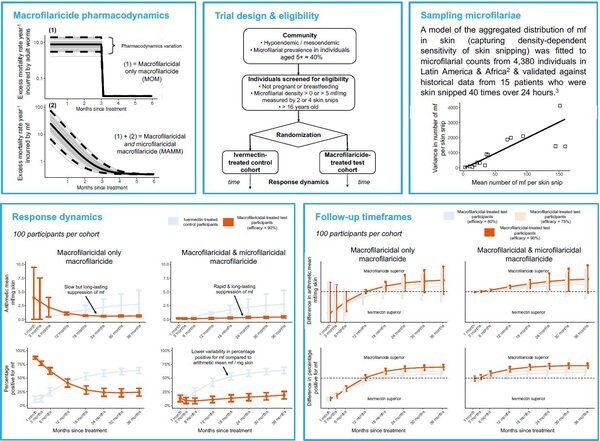ASTMH 2017 Poster - Designing antifilarial drug trials using clinical trial simulators

Poster presented at ASTMH 2017 by Martin Walker, Philip Milton, Jonathan Hamley, Frédéric Monnot, Belén Pedrique & María-Gloria Basáñez
Introduction
Current therapeutic options for patients infected with Onchocerca volvulus, the causative filarial parasite of onchocerciasis are:
- Only partially curative after multiple doses, being predominantly active against the skin-dwelling microfilarial progeny (transmission stages) of O. volvulus;
- Require protracted courses of daily treatment (e.g. antiwolbachial tetracycline antibiotics), and;
- Have unacceptable side effects (e.g. suramin).
Drugs for Neglected Diseases initiative (DNDi) aims to develop or repurpose compounds with improved macrofilaricidal efficacy (killing of adult parasites) and safety to better serve patients living with this debilitating and disabling parasitic infection.
EPIONCHO-IBM
Individual-based analogue of the EPIONCHO transmission model1 tracking the number of adult O. volvulus worms and microfilariae (mf) within individual (human) hosts. Host births and deaths are based on the typical demography of rural low income communities in Africa and individuals are differentially exposed to blackfly bites, driving the typically overdispersed (aggregated) distribution of parasites among hosts. Exposure to blackfly bites varies with age and between males and females.
Conclusions/recommendations
- Final microfilarial assessment should be undertaken at 12 – 18 months after treatment, depending on concomitant microfilaricidal activity of a macrofilaricide.
- A macrofilaricidal efficacy of 75% should be considered as minimally acceptable because an observable difference with ivermectin is unlikely at lower efficacies or will require larger sample sizes.
- Presence of mf ( > 0 mf/mg skin) is a better inclusion criterion than a minimum density (e.g. > 5 mf/mg skin) because of increasing measurement error with increasing mf densities.
- The percentage of participants positive for mf is a useful & more powerful outcome measure in low (hypoendemic) to moderate (mesoendemic) transmission settings (microfilarial prevalence in individuals aged 5+ ≈ 40%).
- Measuring mf with 4 vs. 2 skin snips increases sensitivity to detect infected participants, but has negligible impact on the required sample sizes.
- Interim parasitological assessments are recommended to give an early indication of macrofilaricidal efficacy (e.g. at 6-12 months). Early assessment (e.g. after 1-2 months) will detect microfilaricidal activity.
References
1. Basáñez, M. G. et al. River Blindness: Mathematical Models for Control and Elimination. Adv Parasitol 94, 247-341 (2016)
2. Bottomley, C. et al. Modelling Neglected Tropical Diseases diagnostics: the sensitivity of skin snips for Onchocerca volvulus in near elimination and surveillance settings. Parasite & Vectors 9, 343 (2016).
3. Picq, J. J. & Jardel, J. P. [(A method of evaluating microfilaria densities of Onchocerca volvulus Leuckart, 1893, in onchoceriasis patients.
Assessment of microfilarial densities by site and levels of prevelance in skin biopsies; variations of microfilarial densities over a 24 hour period)]. Bull World Health Organ 51, 145-153 (1974).
